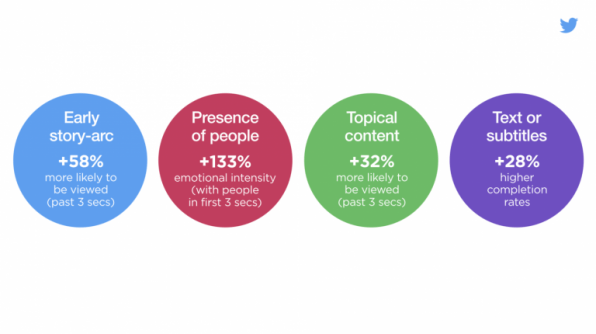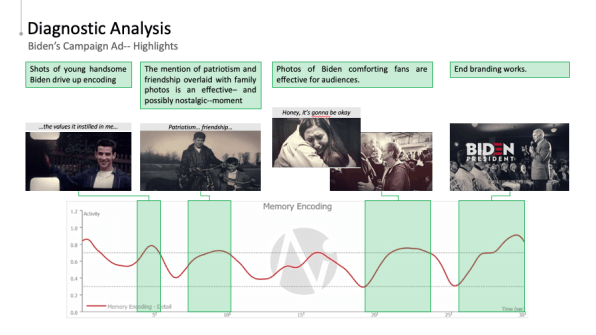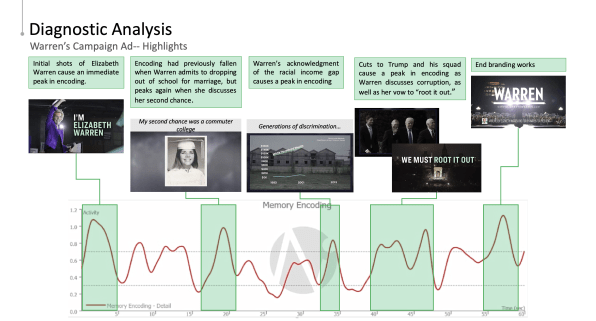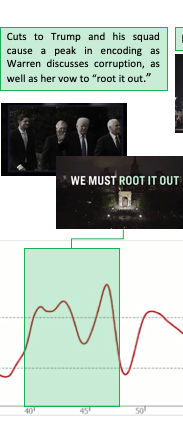What makes for an effective political ad?
With the 2020 presidential election underway, that question could shape America’s future. And it’s not an easy one to answer, despite growing scrutiny over the role advertising will play in the 2020 election. A record $6 billion is expected to be spent on political ads this year, and a much greater share of that money will pour into digital platforms—most notably Facebook—that feature lighter regulation than TV and incredibly granular ad targeting. But that only increases the importance of knowing which ads actually persuade voters.
Until recently, it’s been hard to know what works. Digital ad metrics—such as impressions, view time, and click-through rates—provide an incomplete picture. A bump in the polls can’t be attributed to any particular ad. And focus groups are notoriously unreliable.
But what if you could peek inside voters’ brains instead? Over the past couple of years, I’ve been covering a new trend called neuromarketing that provides a more precise way of measuring an ad’s effectiveness, by using brain-tracking technology to test how people respond to ads. And recently, my colleague Shane Snow and I conducted a study of Democratic primary political ads with a neuromarketing firm called Neuro Insight to see what really breaks through to voters.
This research—along with other neuromarketing studies I’ve reviewed—provides an often-counterintuitive guide to how political candidates can win at the ad game across platforms. The key isn’t just how you spend your money. It’s how you create ads that literally change voters’ minds.
You need to open with a compelling personal narrative
We tested ads for three leading Democratic candidates—Joe Biden, Elizabeth Warren, and Bernie Sanders—using Neuro Insight’s advanced Steady State Topography (SST) technology with a statistically significant sample of registered Democrats. We gauged four metrics: engagement, emotional intensity, approach/withdraw (the positive or negative experience of that emotion), and long-term memory encoding. Memory encoding was the most significant metric for a political ad, since it correlates with decision-making. (Methodology here.)
One big trend we saw in the ads we tested was the power of opening an ad with a candidate’s personal narrative.
This Elizabeth Warren ad, for instance, opens with Warren narrating the story of how she grew up in Oklahoma, saw her brothers go off to the military, got married at 19, and then got a second chance with a $50 commuter college. All four metrics—and most dramatically, memory encoding—spike at the happy ending of the story, pulling voters in.
This particular study was conducted by showing the ads in a natural setting, interspersed in the commercial breaks of episodes of Modern Family and NCIS. But further research from Neuro Insight shows that this is a winning formula for social media ads as well.
In a study of in-feed social video ads, the research found that ads with an early story arc were 58% more likely to be viewed past 3 seconds, and the presence of people in the ad increased emotional intensity by 133%.

Across Facebook, YouTube, Instagram, TV, and every other ad distribution channel, candidates need to jump into a compelling personal narrative from the start.
Show real people experiencing real emotions
Stock video is the bane of the marketing and advertising world. It’s also kryptonite for political advertising.
In the ads tested, stock footage of people working, driving, etc., caused all four metrics to plummet. What worked well, however, was showing real people experiencing strong emotions.
This was most notable in the Joe Biden ad we tested, which elicited the strongest emotional response. Shots of Biden meeting and hugging voters elicited strong positive emotion. And in the Warren and Sanders ads we tested, shots of supporters responding emotionally to the candidates drove high levels of engagement.
As humans, we respond to seeing the emotional impact that candidates have on other people. This makes sense. Researchers believe we’ve evolved to mimic and adopt the emotions of others, a phenomenon called emotional contagion. Political ads are stuffed with bland stock footage; replacing that with footage of real supporters would likely deliver a serious boost.
Focus on the issues, but make them human
Many candidates want to focus on the issues. But it can be difficult to do so while still holding voters’ attention.
Take the Bernie Sanders ad we tested. It dives right into Sanders’s work on issues such as raising wages, healthcare, and civil rights. But the end result wasn’t memorable or engaging for respondents.
We also saw dips across all four metrics for Warren’s and Biden’s ads when they transitioned from their personal stories to the issues, although they did find some strategies that worked.
Warren’s ad, for example, drove high levels of memory encoding and emotional response when she talked about second chances and the racial wealth gap. She speaks about these issues in an empathetic way, and voters lean in, perhaps buoyed by the personal connection she’s established at the top of the ad.
Biden’s ad doesn’t focus on the issues, but it does end his “middle class” message on a high note by showing images of him comforting fans. If candidates want their stance on the issues to break through, they’ll likely need to leverage the power of a personal narrative and emotional imagery to do so. And in shorter social video formats, they’d be smart to limit their focus to just one issue.

Optimize for branding moments
Neuro Insight has found that one of the most effective advertising strategies is to optimize for “branding moments.” These are moments in which respondents have a high level of memory encoding and the candidate (or brand’s) name or image is being shown on screen.
The logic here is pretty simple. You want people to remember your face or name.
Warren’s ad does a very effective job of this. It has three peak branding moments that scored in the top 90th percentile of all ads Neuro Insight has tested. She does this strategically. First, it turns the usual boring disclosure (“I’m X and I approve this message”) that comes at the end of the ad into a branding moment at the beginning. Engagement and memory encoding spiked when she opens the ad with the disclosure accompanied by her name in large text over a dramatic photo of herself.

Next, she hits a key branding moment with her key catchphrase in large text on screen: “I’ve got a plan for that.” Finally, she closes with a powerful image of her in the spotlight in front of adoring fans—a peak branding moment that scored in the 98th percentile. These branding moments are the primary reason Warren’s ad is projected to make a lasting impact. They’re also a reason to feel optimistic about Warren’s chances if she can outperform expectations in Iowa and New Hampshire, raise money, and invest in big-time advertising before Super Tuesday.
Our research also pinpoints a branding moment hack; the image of each candidate in front of a crowd of fans triggered peak branding for both Sanders (65th percentile) and Biden (87th).
Brand Trump as corrupt
Change Research has found that messages centered on President Trump’s corruption are the most effective at dampening support for him. Warren’s ad hit on this message effectively well. Engagement and memory encoding jumped when it showed shady footage of Trump and his associates with “corruption” and “we must root it out” in large text. In many ways this is another effective branding moment—except this time, against Trump.

Ultimately, to win the multiplatform advertising war of 2020, Democratic candidates are going to have to use every tool at their disposal—possibly the unique insights neuroscience can provide. That’s because it isn’t just about how much money you spend on ads. It’s about how well those ads work.
Joe Lazauskas is the VP of marketing at Contently and co-author of The Storytelling Edge, a book about the science of storytelling and how to use it to transform your business.
Fast Company , Read Full Story
(44)